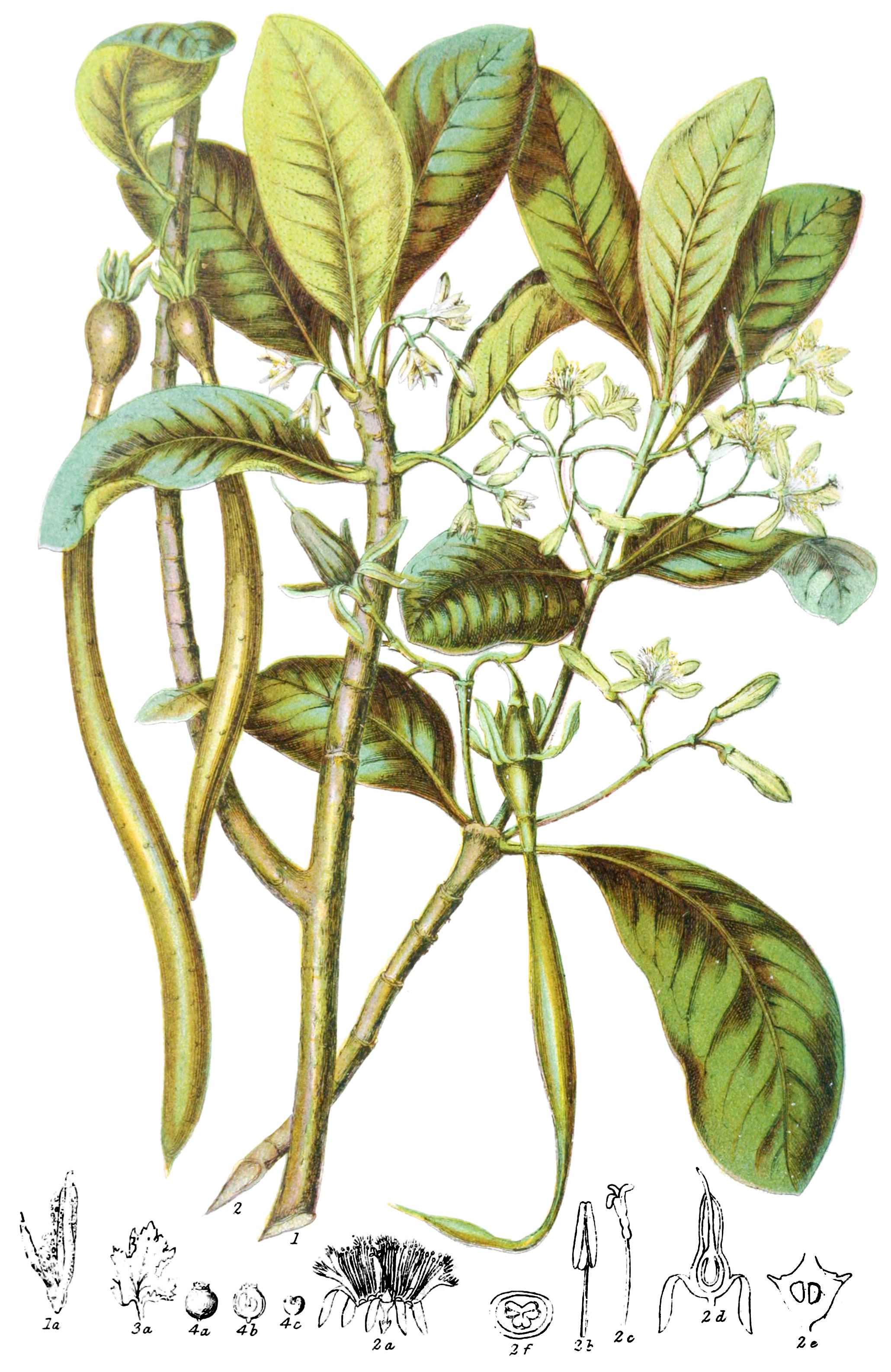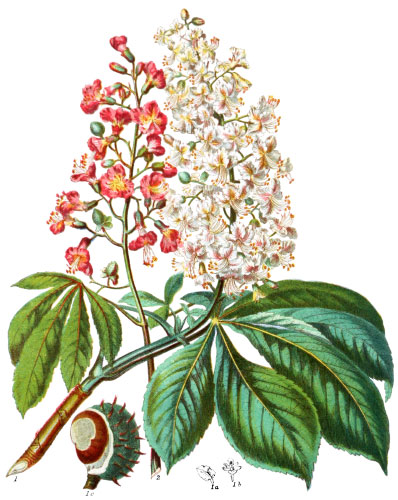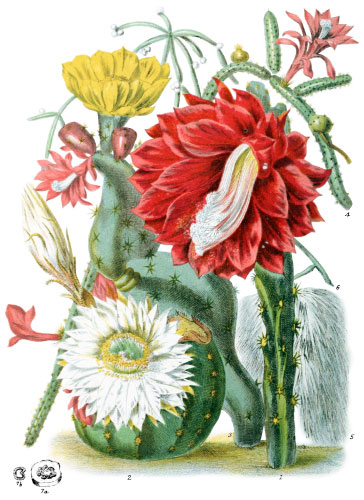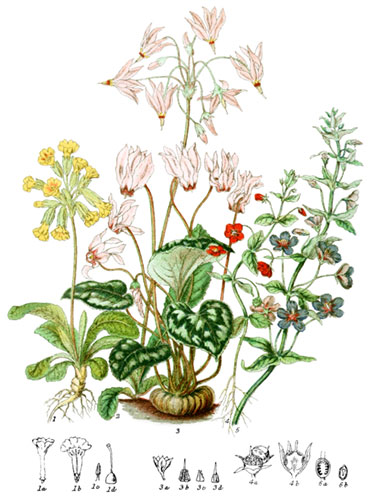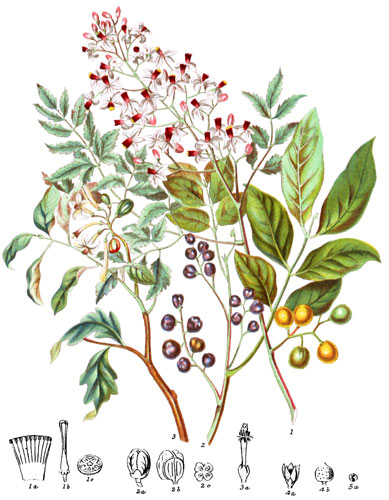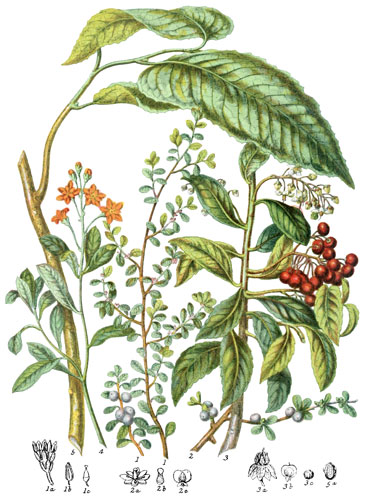Key characteristics
Trees and shubs, the leaves of which are simple, opposite, sometimes dotted beneath, entire at the edges, or toothed, with convolute deciduous stipules between the leaf-stalks. The flowers grow at the ends of the branches, or at the base of the leaf-stalks; the calyx is surrounded at its base by a cup-shaped bract; the lobes are valvate in the bud, and are from four to twelve in number; occasionally all cohere at their points and edges. The petals arise from the calyx, are equal in number to its lobes, and alternate with them. The stamens grow from the calyx with the petals, and are either twice or thrice their number, or nerous; the filaments are distinct, the anthers erect. The ovary is two, three, or four-celled, each cell containing two or more ovules suspended from the top of the central angle. The fruit is closed, crowned by the calyx, one-celled and one-seeded. The seed is pendulous, contains no albumen. The radicle is very long, piercing the fruit when mature, and descending to the ground.
This singular Tribe has affinity in structue with some allies of the Myrtle Tribe, with Belvisiaceæ in its wood, and with several others, but it is clearly distinguished from all by the seed growing in the fruit, with a single exception of Ægiceras in Myrsinaceæ.
The bark is generally astringent.
Select plants in this order
Not all plants listed are illustrated and not all plants illustrated are listed.
- Rhizophora derives its name from the Greek, in allusion to the roots which it bears profusely from the stem above ground. The Dutch named it wilde Runboom in their East Indian colonies; the French call it Paletuvier; the Spaniards, Mangle.
- Throughout the Troipcs, on the banks of large rivers, and along the coasts of the ocean, are vast tracts of Rhizophora Mangle (1) bordering the land with a dense mass of spreading trees down to low-water mark, intercepting the rays of the sun, and causing an extremely unhealthy climate. The natives are able to pass by climbing dexterously through the interlacing roots and branches, without treading on the dangerous quagmire below. No one ventures to remain long in the malaria of such regions. The trees have a pecuilarily remarkable appearance, standing on the verge of land and water, apparently propped up by the numerous roots which proceed from the stem and descend in an arched form to the ground or water. A very singular effect is also added by the long seed-vessels germinating on the branches. To the first Europeans who penetrated amongst the islands of the Caribbean Sea the spectable must have been astonishing. The course of rivers is often interrupted by the encroaching swamps, and travellers are occasionally obliged to cut a passage for their boat; on the west shores of Borneo the landing at the moutth of some rivers is nearly impracticable from the accumulation of mud amongst the roots. When the radicle of the seed is developed and has pierced the capsule, the young plant is ready to take root immediately on reaching the mud, having the rare property of resisting salt water, and thus its growth is secured amidst circumstances unfavourable to any other class of flowering plants. By the time the tree has attained two or three feet in height, it begins to send forth branches, and then fresh roots from th estem; at the twelve feet it ceases to grow upwards, but spreads in branches. The roots at first are fragile, but become firm and of a grey colour. If their points receive any injury, they do not advance in length, though fresh branches sprout above, thus forming an entangled thicket, in which birds and insects innuerable find an abode: on the sea-coast, oyster also attach themselves to the branches which are submerged. The flowers have sometimes a slightly agreeable scent; the anthers soon fall off, the style is prolonged into the fruit, said to be eatable, and the juice capable of fermentation into wine.
- Kandelia (2) is derived from the native name in Malabar, where the trees abound, as well as on the shores of the Ganges: the specific name is in remembrance of Van Rheede, an early Dutch traveller in India. The wood serves for fuel, the bark is dried with ginger and used as long pepper. The petals are still more finely fringed than those of Rhizophora; this species has been lately discovered growing also in an estuary at Little Hong Kong.
- Carallia, the Carallie of the Telingas, is a genus of small evergreen trees extending beyond the usual tropical limits of this tribe, northwards in India.
- C. lucida (4)* grows on the lower range of the Circar mountains, as well as in Kemaon and Silhet.
- C. sinensis has been found in a ravine of Mount Victoria in Hong Kong. The petals of this genus are not fringed as others, merely wrinkled or notched at the edges, and the fruit is a small round berry, the seeds of which do not germinate in the seed-vessel.
- The astringent bark of Bruguiera gymnorhiza of Java and Moluccas is used for dyeing black. The wood of several species is described to be hard and durable.
- A Bruguiera, whose ten-lobed calyx resembles strips of red leather, is one of the remarkable plants which attract the attention of a colonist or settler on the muddy shores of the Brisbane river, Australia. Less than twenty years ago, the site of the now properous port of Adelaide was a Mangrove swamp.
Locations
This singular Tribe inhabits the shores of the Tropics; Carallia penetrates into the north of India.
Legend
- Rhizophora Mangle. Mangrove. Tropical Shores.
- Rhizophora macrorhiza. Anther magnified.
- Kandelia Rheedii. Malabar and the Ganges.
- Flower open.
- Stamen.
- Pistil.
- Seed germinating.
- Section of Ovary.
- Cross Section.
-
- Carallia zeylanica. Petal. Ceylon.
-
- Carallia lucida. Berry.
- Section of Fruit.
- Seed.
*4 was mentioned in the original description but only 4a–4c were illustrated.
Explore more
Posters
Decorate your walls with colorful detailed posters based on Elizabeth Twining’s beautiful two-volume set from 1868.
Puzzles
Challenge yourself or someone else to assemble a puzzle of all 160 botanical illustrations.
